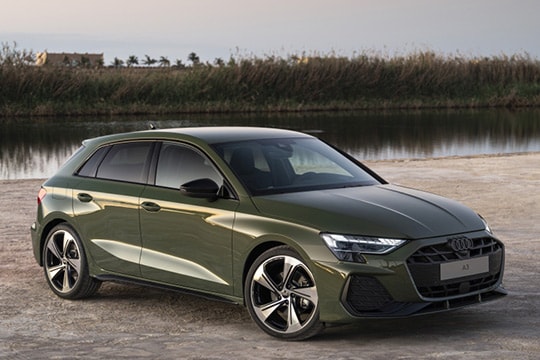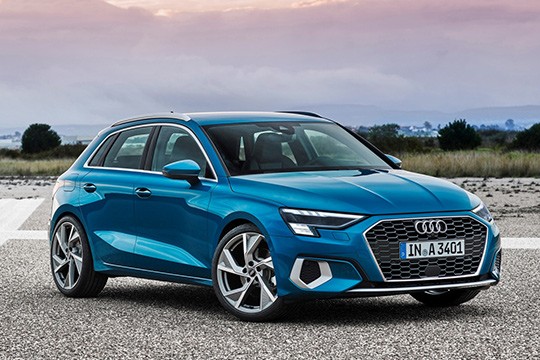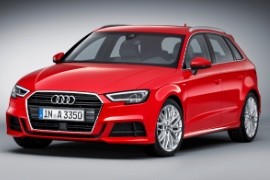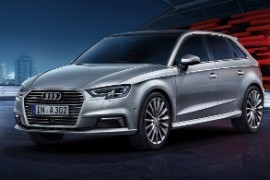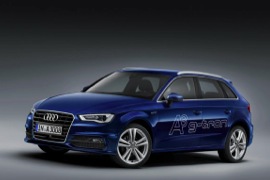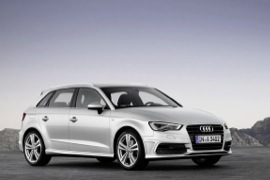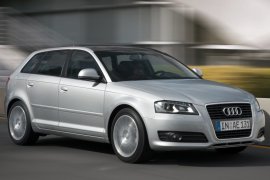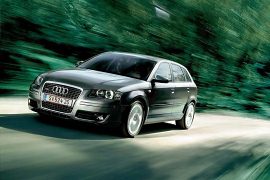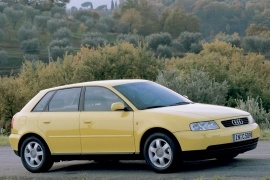AUDI A3 Sportback Models/Series Timeline, Specifications & Photos
First production year: 1999
Engines: Mild hybrid diesel, Mild hybrid, Gasoline, Diesel, Natural gas, Hybrid
Body style: Hatchback
The fourth generation of the A3 received an upgrade four years after its introduction in 2020, and the new model came with significant improvements that made it more distinguishable than its non-facelifted brother.
When Audi introduced the first generation of the A3 back in 1996, it offered it exclusively as a three-door hatchback. The five-door version, which was known as the Sportback, came three years later, in 1999. Over the years, the three-door version was axed from the assembly lines due to poor sales, so the Sportback remained one of the original versions of this nameplate. In 2024, the Sportback went through some changes along with the rest of the A3 range, and the upgrades were significant.
At the front, the 2024 A3 Sportback surprised its customers with a choice of three headlights. They all featured LED technology, but only the highest one was fitted with the Matrix-LED system. Between them, the automaker installed an active singleframe grille that could open or close its flaps to bring more or less air into the engine compartment. Furthermore, Audi installed a set of air intakes in the center that cooled the front discs. On the sides, the scoops installed were covered by nicely designed caps, but they didn’t let any air pass through them.
From its profile, the five-door hatchback vehicle looked almost identical to its predecessor. However, Audi offered new styling for the wheels, which ranged between 16- and 19-inches in diameter. The automaker also added new options for the side trims, including a black one that made the A3 Sportback look more like a three-door hot-hatch than a regular, five-door one. At the back, the automaker added new taillights featuring outward-pointing arrows in their upper area and dynamic turn signals in the lower one. Furthermore, depending on the trims and options, the automaker installed a diffuser.
Inside, Audi tried to spoil its customers with rich features that were included as standard. In addition, the dashboard was adorned with new cloth materials in its lower area. Thanks to the new blade design for the vents, these appeared to be narrower than before. Fronting the driver was the same LCD known as the Audi Virtual Cockpit, complemented by a touchscreen atop the center stack for the infotainment system. The most significant update for it was the ability to download third-party apps into the system. Audi redesigned the center console and adorned it with a matte metallic finish that matched the color of the door handles. Furthermore, vehicles fitted with an automatic transmission featured a new drive selector resembling a slider that moved front and rear. Another unique detail of the cabin was noticed on the door cards that featured 300 cuts for the ambient lighting. In the back, the split-folding (40/20/40) bench seat could accommodate three passengers. However, the one seated in the middle had limited legroom due to the center tunnel.
Audi launched the refreshed A3 Sportback with a choice of two engines: a gasoline and a turbodiesel. Both were helped by 48-volt mild-hybrid systems that helped them lower emissions. Both were paired with either a seven-speed automatic (dual-clutch) transmission or a six-speed manual.
AUDI A3 Sportback 35 TDI 1.5L MHEV 7AT S-tronic FWD (150 HP)
AUDI A3 Sportback 35 TFSI 1.5L MHEV 7AT S-tronic FWD (150 HP)
The third generation for Audi's compact vehicle was launched under the sad auspice of the canceled 2020 Geneva Motor Show. But the car was launched anyway and Audi moved on. The new design lines maybe will catch on, but some details are strange looking to say at least.
From the get-go, there are only three engines available: a 1.5-liter TFSi unit with 150 hp and a 2.0-liter TDI engine with two outputs, a 110 hp and a 150 hp, respectively. The standard gearbox is a six-speed manual, but a 7-speed DSG is offered as an option.
The exterior look makes a bold statement, with some design cues around the front fog lights looking like horseshoes. The headlights are Matrix-LED depending on options or trim level, and the daytime running lights are arranged into a 3 by 5 pattern, for an easier recognition of the car. The length of the car has grown only by 3 cm (1.2 in) from the previous generation, to a total of 4.34 m (14.2 ft).
Unlike the first generation, which had a rear independent suspension, the latest A3 has a semi-rigid axle for the engines under 150 hp. For the other ones, it has a 4-link independent system, which ads more comfort and better handling.
The starting price for the 2020 Audi A3 Sportback is EUR 28.900 for the gasoline version with manual transmission in Germany.
More expensive than the Ford Focus or the VW Golf, the Audi A3 Sportback offered a roomy cabin with nice luxury touches. Sharing its platform with the VW Golf and the Seat Leon, the A3 Sportback was a better choice.
While the exterior design was very similar to the previous generation’s, the cabin was fitted with high-quality materials and advanced technology.
Visual updates included a redesigned front end with new headlights and larger air intakes, while at the back the A3 featured new stoplights and a slightly redesigned rear bumper.
The new model featured the Audi’s Virtual Cockpit with a 12.3-inch touchscreen display with loads of information to offer without distracting the driver.
The customers could connect their mobile devices using the integrated Android Auto or the Apple CarPlay systems. The optimised MMI controlled made everything easier to action.
To enhance utility, a wireless charging pad was placed under the armrest.
Practical to live with, the A3 Sportback offered a roomy cabin with enough head, leg and shoulder room for all of the occupants.
The cargo area was comparable to the VW’s Gold, with plenty of space for luggages.
The new 2016 model offered a choice of 6 engines, three gasoline and three diesel powerplants. The power ranged from 110 hp to 190, while all models complied to the euro 6 standard.
The plug-in hybrid version of the premium-compact hatchback from Audi went through a facelift in 2016. It joined the rest of the revamped lineup of the A3.
Audi started to build electrified models for several years and the A3 was seen as the best option to start with, due to its high demand on the market and light bodywork. Moreover, the car didn't need too many batteries to transport its occupants around town, since it also featured an internal combustion engine.
To distinguish it from the rest of the stable, the A3 e-tron featured a big, silver, single-frame grille. It was interrupted only by the bar needed for the license plate. A new pair of Matrix LED headlights were offered as an option, while the standard came equipped with Xenon plus units as standard. Behind the Audi badge on the grille, there was the charging port
Inside, the Audi A3 sportback e-tron featured the same premium interior as for the other versions. It featured a standard automatic transmission and an infotainment system that supported Google maps The instrument cluster featured different dials for the charging or driving modes.
Under the hood, there was a 1.4-liter turbocharged gasoline engine with direct injection or TSI for short. It was aided by an electric motor of 75 kWh. In total, both engines offered 204 hp. If charged from a 120 V plug, the charging time took around 8 hours, but charged from a 240 V outlet would cut that time to just barely two hours.
The plug-in hybrid version of the 5-door Audi A3 Sportback was a nice addition to the range. Instead of building a completely new vehicle, the Audi engineers took the MQB based A3 and stuck an electric motor plus some batteries inside and transformed it into the A3 Sportback e-tron.
The system has a 1.4-liter TSI gasoline engine in the front that offered 150 hp. The 100 hp electric motor was installed between the engine and the 6-speed dual-clutch automatic transmission. It was the same wining principle from the Prius, but better since it was a plug-in hybrid. The charging port was nicely hidden behind the four-circle badge on the grille.
The parallel driving system allowed the vehicle to run only on fuel, in hybrid mode or in pure EV mode. In the latter mode, it could have be driven up to 50 km (31.1 miles). In hybrid mode, the 1.4-liter TSI worked together with the electric motor, adjusting the revs to the motor. Most of the departures were done in electric mode and only after the engine kicked in.
The driver had the option to choose the driving mode. It could be left on “Auto” so the computer could manage the assembly in hybrid mode, gasoline-only to preserve and charge the battery, or EV only. In other words, the driver could have preserved and charged the batteries so no one will know that the e-tron is pulling up the driveway late at night.
In 2013, Audi introduced on the market the Audi A3 Sportback g-tron as an answer for ecological vehicles. But it was more than that.
The quest to lower emissions, the car-manufacturers were forced to find new ways to offer less polluting vehicles either by introducing electrified or electric vehicles or, as Audi did, tried a different approach.
The CNG is a compressed natural gas that can be associated with the regular gas from the stove. But to be stored in a larger quantity, it had to be compressed into special tanks. It was a good idea as long as it didn't lose the content. The CNG was used for fleet vehicles and public transport, due to its complete combustion. When it burns, the CNG emits vaporous water and carbon dioxide, but not any NOX or other dangerous particles for health.
The Audi A3 g-tron was a very good offer for compact fleet cars. Moreover, it had two tanks: one for regular gasoline and a special one for the compressed gas. The small and economical engine was tuned for better fuel-efficiency and could seamlessly switch from gas to gasoline and back.
The main drawback of a CNG engine is that in cold weather it cannot start the engine. So, the computer-controlled fuel system automatically started on gasoline, and, after the engine was heated up, it switches on CNG.
In 2012, at the Geneva Motor Show, Audi launched the third generation of its compact-class contender, the A3 Sportback. It is based on the MQB platform, Volkswagen's modular platform used for more vehicles in the group. But the A3 is the first to use it. The Sportback was available in three or five-door bodywork.
Later on, from the A3 family, another three vehicles emerged: A3 Cabriolet, A3 Sedan and the Q3 crossover. The outside dimensions were slightly bigger than those of its predecessor, with a total length of 4310 mm (169,7 in), a 1785 mm (70.3 in) width and a 1421 mm (55.9 in) height.
The cabin is large enough for five passengers, especially the five-door versions. The car has received a very good crash-test rating, being credited with a 5 star EuroNCAP rating under the new regulations. Numerous safety features were installed in the A3, such as lane assist, radar for collision avoidance, adaptive cruise control, and an automated system that braked the vehicle after a collision.
The available engines available at the launch were four-cylinder turbocharged units with either gasoline or diesel. The base was a 1.4-liter with 122 hp, while the top version was a 1.8-liter TFSI four-pot with 180 hp. For the diesel, there was only a 2.0-liter TDI engine available with 150 hp.
All-wheel-drive quattro transmission was available for the top diesel and gasoline versions.
Inside, a new MMI unit is installed with handwriting recognition and Apple CarPlay and Android Auto compatible.
AUDI A3 Sportback (5 doors) 1.2L TFSI 6MT (110 HP)
AUDI A3 Sportback (5 doors) 1.2L TFSI 7AT (110 HP)
AUDI A3 Sportback (5 doors) 1.4L TFSI 6MT (125 HP)
AUDI A3 Sportback (5 doors) 1.4L TFSI 7AT (125 HP)
AUDI A3 Sportback (5 doors) 1.4L TFSI CoD 6MT (150 HP)
AUDI A3 Sportback (5 doors) 1.4L TFSI CoD 7AT (150 HP)
AUDI A3 Sportback (5 doors) 1.8L TFSI 6MT (180 HP)
AUDI A3 Sportback (5 doors) 1.6L TDI 6MT (110 HP)
AUDI A3 Sportback (5 doors) 1.6L TDI 7AT (110 HP)
AUDI A3 Sportback (5 doors) 2.0L TDI 6AT (150 HP)
AUDI A3 Sportback (5 doors) 2.0L TDI 6MT (150 HP)
AUDI A3 Sportback (5 doors) 2.0L TDI 6MT (184 HP)
Audi introduced a facelifted version of the A3's second generation in 2008, and those updates were also featured on its five-door version, also known as Sportback.
The German automaker tried its luck with the A3 in 1996 when it launched it since it was based on the same platform as the Golf. Some critics said that it was just a more expensive version for that, and judging by many aspects, that was right. But along with the second generation of this hatchback, some features and drivetrains differentiated these German hatchbacks even more. In addition, the premium-oriented sibling wasn't available as a station wagon.
The second generation of the A3 was offered in three body versions: three-door, five-door, and a convertible with soft-top. At the front, it sported the "single-frame" grille introduced by the A8, which gained more fans. A redesigned front bumper was present as well. The five-door version was slightly longer than its three-door sibling, although it didn't gain anything in the wheelbase. The automaker enlarged the rear overhang to accommodate the posterior doors and still provide a decent trunk.
Inside, the five-door version received an updated instrument panel, ditching the old red TFT display from within the main dials. Instead, it got a new LCD that showed more information pleasantly. In addition, on the center stack, Audi provided a touchscreen for the infotainment system as an option. Finally, thanks to the five-door bodywork, the Sportback offered easier ingress and egress to the vehicle for the rear-seated passengers.
Under the hood were engines from as little as a 1.2-liter up to a 3.2-liter V6 unit. Depending on the powerplant and trim level, the A3 was equipped with manual or DSG (dual-clutch) gearboxes.
AUDI A3 Sportback 1.2L TFSI 5MT (105 HP)
AUDI A3 Sportback 1.2L TFSI 7AT (105 HP)
AUDI A3 Sportback 1.4L TFSI 6MT (125 HP)
AUDI A3 Sportback 1.4L TFSI 7AT (125 HP)
AUDI A3 Sportback 1.6L 5MT (102 HP)
AUDI A3 Sportback 1.6L 7AT (102 HP)
AUDI A3 Sportback 1.8L TFSI 6MT (160 HP)
AUDI A3 Sportback 1.8L TFSI 7AT (160 HP)
AUDI A3 Sportback 1.8L TFSI quattro 6MT (160 HP)
AUDI A3 Sportback 2.0L TFSI 6AT (200 HP)
AUDI A3 Sportback 2.0L TFSI 6MT (200 HP)
In 2004, the Audi A3 received an update, coming with a completely new front end, big grille, refreshed headlights, new bumpers, and new wheels and exterior finishes. Its five-door version was named Sportback just to differentiate it from the three-door version, named hatchback.
The second-generation of the Audi A3 was launched at the 2003 Geneva Motor Show. It was based on a new platform and, in June 2004 the Sportback version with five doors was introduced to the market. On the hatchback segment, the Sportback was the only premium car that offered five doors. The BMW 3-Series Compact and the Mercedes-Benz Sportcoupe were available only in three-door versions.
There was a new design signed by Walter da Silva but it featured the new front grille introduced for the first time on the Audi A8 W12. When compared to the 3-door version, the A3 Sportback was longer by 80 mm (3.14”) due to a longer wheelbase. On the roof, the customer could choose a pair of silver roof-rails. The rear had received a new bumper and A4-style taillights. Its third stop-light was installed on the small roof-spoiler.
Inside, there was room for five passengers. It was a premium compact-sized vehicle that featured premium amenities such as automatic climate control, a new semi-automatic transmission. Leather seats and sport-bucket seats were offered as an option, or standard on specific models.
Compared with its rivals, the A3 Sportback was available with all-wheel-drive systems.
AUDI A3 Sportback 1.4L TFSI 6MT FWD (125 HP)
AUDI A3 Sportback 1.6L 5MT FWD (102 HP)
AUDI A3 Sportback 1.6L 6AT FWD (102 HP)
AUDI A3 Sportback 1.6L FSI 6MT FWD (115 HP)
AUDI A3 Sportback 1.8L TFSI 6AT FWD (160 HP)
AUDI A3 Sportback 1.8L TFSI 6MT FWD (160 HP)
AUDI A3 Sportback 2.0L FSI 6AT FWD (150 HP)
AUDI A3 Sportback 2.0L FSI 6MT FWD (150 HP)
AUDI A3 Sportback 2.0L TFSI 6AT FWD (200 HP)
AUDI A3 Sportback 2.0L TFSI 6MT FWD (200 HP)
AUDI A3 Sportback 2.0L TFSI quattro 6MT AWD (200 HP)
AUDI A3 Sportback 1.9L TDI 5MT FWD (105 HP)
AUDI A3 Sportback 1.9L TDI 6AT FWD (105 HP)
AUDI A3 Sportback 2.0L TDI 6AT FWD (140 HP)
AUDI A3 Sportback 2.0L TDI 6AT FWD (170 HP)
AUDI A3 Sportback 2.0L TDI 6MT FWD (140 HP)
AUDI A3 Sportback 2.0L TDI 6MT FWD (170 HP)
The first generation of the premium compact hatchback from Audi was introduced in 1996 as a three-door only. In 1999, a 5-door version was introduced on the market.
The A3 Sportback was the first compact-hatchback on the premium segment. It was built on the Volkswagen Golf IV platform (PQ34), shared with the Seat Leon, and Skoda Octavia. It was the first Audi with a transverse engine. On the same platform, several years later, Audi launched the TT range.
The Sportback was a five-door bodywork and, unlike most of the compact hatchbacks on the market, it featured an additional side window behind the rear doors. The raked tailgate took some space from the trunk but added some points to the image factor.
Inside, the premium materials used were similar to those from its bigger brother, the A4. The instrument cluster featured a clear, four dial design, with an LCD installed between the speedometer and tachometer. Due to the short, 2.5 m (98.9”) wheelbase, the rear seats offered limited legroom for passengers. The trunk was not the biggest in its class, but the split 60/40 rear bench backseat was standard.
The Audi A3 Sportback was available with a wide choice of diesel and gasoline engines, with front or all-wheel-drive. All the gasoline units were mated as standard with a 5-speed gearbox while the top, 130 hp, diesel unit featured a 6-speed manual. A 4- or 5-speed automatic was available as an option.
AUDI A3 Sportback 1.9L TDI 4AT FWD (110 HP)
AUDI A3 Sportback 1.9L TDI 4AT FWD (90 HP)
AUDI A3 Sportback 1.9L TDI 5AT FWD (100 HP)
AUDI A3 Sportback 1.9L TDI 5AT FWD (130 HP)
AUDI A3 Sportback 1.9L TDI 5MT FWD (100 HP)
AUDI A3 Sportback 1.9L TDI 5MT FWD (110 HP)
AUDI A3 Sportback 1.9L TDI 5MT FWD (90 HP)
